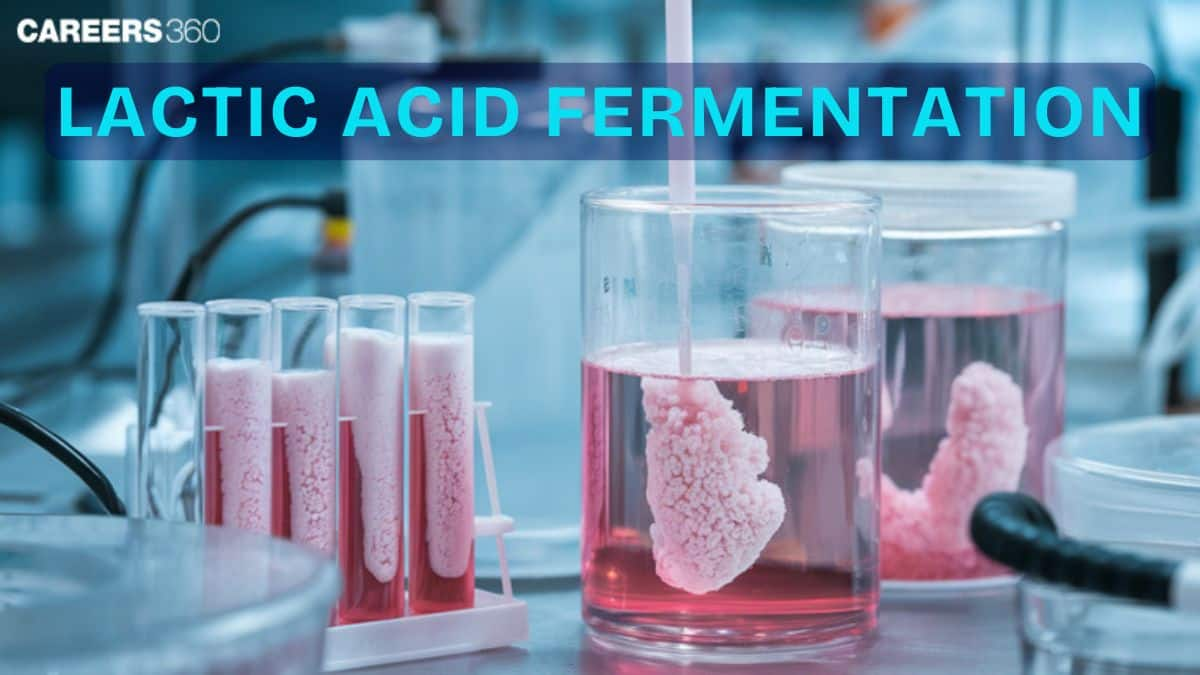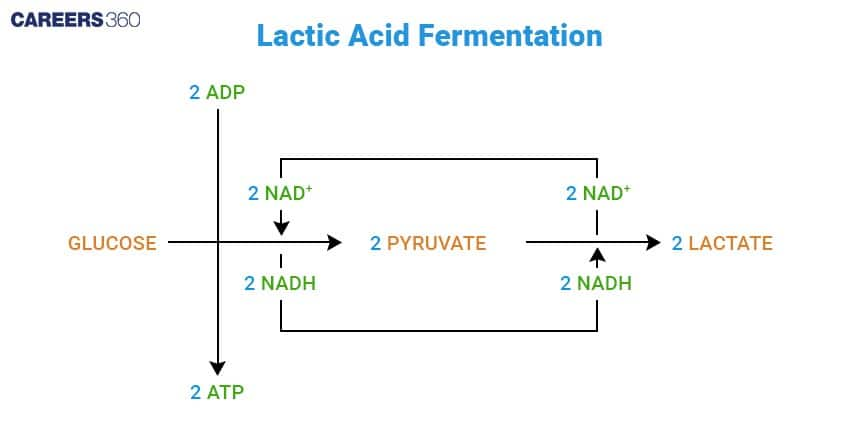Lactic Acid Fermentation: Products, Equation, Examples
Lactic acid fermentation is an anaerobic pathway where pyruvate is reduced to lactic acid to regenerate NAD⁺, allowing glycolysis to continue in the absence of oxygen. This process occurs in muscle cells during intense exercise and in Lactobacillus species used in food fermentation. It is a high-yield NEET topic involving anaerobic respiration, energy production, and microbial applications.
This Story also Contains
- What Is Lactic Acid Fermentation?
- Why Lactic Acid Fermentation Occurs
- Steps of Lactic Acid Fermentation
- Types of Lactic Acid Fermentation
- Uses of Lactic Acid Fermentation
- Health Implications
- Lactic Acid Fermentation vs Alcoholic Fermentation
- Lactic Acid Fermentation NEET MCQs (With Answers & Explanations)
- Recommended video on Lactic Acid Fermentation

What Is Lactic Acid Fermentation?
Lactic acid fermentation is a crucial metabolic process occurring in some bacteria and in the muscle cells of animals. This is an anaerobic pathway that enables the production of energy in the absence of sufficient oxygen. In particular, it allows the continuation of fast muscle contraction during heavy exercise. To comprehend how organisms adapt to living under changing conditions of oxygen availability, it will be essential to be familiar with how lactic acid fermentation works and its consequences.

Why Lactic Acid Fermentation Occurs
Lactic acid fermentation is a process in which pyruvic acid produced from glucose is converted into lactic acid. This process occurs in the presence of the enzyme lactate dehydrogenase and it involves the reduction of pyruvic acid using NADH as a reducing agent. This process has a pretty low total energy yield, less than seven per cent of the energy from the glucose is released.
Under Low Oxygen Conditions
During intense exercise, the demand for oxygen increases but the supply is limited. Hence, the muscles switch to anaerobic respiration. Glycolysis continues only if NAD+ is regenerated via the lactate formation.
In Bacteria
Fermentation primarily takes place in yeast and bacteria. Fermentation represents the incomplete oxidation of glucose in yeast, which produces CO2 and ethanol as the products. However, lactic acid fermentation in some bacterial organisms is characterized by the fermentation of pyruvic acid into lactic acid. It is important for food preservation.
Steps of Lactic Acid Fermentation
The major steps of lactic acid fermentation are as follows:
Glycolysis
In glycolysis, the six-carbon glucose molecule is converted to glyceraldehyde 3-phosphate and then to 3-phosphoglyceric acid.
NAD+ Reduction
In these two reactions, the NAD+ is reduced to the reducing agent NADH.
Formation of Pyruvic Acid
The 3-phosphoglyceric acid is further converted to phosphoenolpyruvic acid, which then undergoes reduction to form pyruvic acid.
Conversion to Lactic Acid
The pyruvic acid, in turn, is converted into lactic acid by using NADH, which, during this process, is reoxidized back into NAD+. In this reaction, two molecules of pyruvic acid get converted into two molecules of lactic acid.
Types of Lactic Acid Fermentation
There are two types of lactic acid fermentation:
Type | Description |
Homofermentative |
|
Heterofermentative |
|
Uses of Lactic Acid Fermentation
The significant applications of lactic acid fermentation are in the food industry, particularly in food preservation and production. The bacteria usually used is Lactobacillus, which helps to create all these different fermented products like pickles, sour beer, fermented fish, and yoghurt. The effects of preservation resulting from lactic acid prevent the growth of spoilage organisms and pathogens in these products.
Health Implications
Though lactic acid fermentation is quite useful in food production, too much lactic acid in muscle cells as a result of intense exercise might be responsible for muscle cramps and discomfort. It builds up in cases where the oxygen supply is inadequate, initializing the anaerobic respiration and consequently the production of lactic acid. Lactate is transported to the liver where it is converted back to glucose through the Cori cycle.
Lactic Acid Fermentation vs Alcoholic Fermentation
The two types of fermentation are lactic acid and alcoholic fermentation. Both have differences that are included in the table ;
Feature | Lactic acid | Alcoholic |
Organism | Muscles, bacteria | Yeast |
Product | Lactic acid | Ethanol and CO2 |
Enzyme | Lactate dehydrogenase | Pyruvate decarboxylase and alcohol dehydrogenase |
ATP | 2 ATP | 2 ATP |
CO2 evolution | No | Yes |
Lactic Acid Fermentation NEET MCQs (With Answers & Explanations)
Important topics for NEET are:
Steps of lactic acid fermentation
Lactic acid vs Alcoholic fermentation
Practice Questions for NEET
Q1. The most abundant prokaryotes helpful to humans in making curd from milk and in production of antibiotics are the ones categorised as:
Cynabacteria
Archaebacteria
Chemosynthetic autotrophs
Heterotrophic bacteria
Correct answer: 4) Heterotrophic bacteria
Explanation:
The most abundant prokaryotes helpful to humans in making curd from milk and in the production of antibiotics are heterotrophic bacteria. Heterotrophic bacteria are useful to humans in a variety of ways. But they are also known to cause various harmful diseases.
Hence, the correct answer is option 4) Heterotrophic bacteria.
Q2. What amount of energy is released from glucose during lactic acid fermentation?
More than 18%
About 10%
Less than 7%
Approximately 15%
Correct answer: 3) Less than 7%
Explanation:
Lactic acid fermentation is an anaerobic (oxygen-free) process that converts glucose to lactic acid and ATP, which is the energy source. During aerobic respiration, 38 ATP are released per glucose molecule. During lactic acid fermentation, less than 7 % of the total energy in glucose During alcoholic fermentation, 2 ATP is released per glucose molecule.
Hence, the correct answer is option 3) Less than 7%.
Q3. What type of reaction is lactic acid fermentation?
Oxidation
Reduction
Hydrolysis
Dehydration
Correct answer: 2) Reduction
Explanation:
Lactic acid fermentation is a critical anaerobic process that transpires in the absence of oxygen, wherein pyruvate, a glycolysis byproduct, is transformed into lactic acid or lactate. This biochemical event exemplifies a redox reaction, during which NADH is oxidized back to NAD⁺, a pivotal step because it facilitates the persistent production of ATP via glycolysis despite oxygen scarcity. The essential chemical transformation is succinctly represented as:
Pyruvate + NADH ⇌ Lactic acid + NAD⁺
This mechanism is frequently observed in muscle cells during rigorous physical activities when the oxygen supply is inadequate to meet the cell's energy demands. Additionally, certain microbes, such as lactic acid bacteria, also exhibit this fermentation pathway. The significance of regenerating NAD⁺ lies in its role as an electron acceptor in glycolysis, thus ensuring the continuation of the energy-yielding process even in anaerobic conditions. Consequently, this process is vital for organisms that encounter environments lacking in oxygen, such as muscle cells during intense exercise and the aforementioned bacterial species.
Hence, the correct answer is option 3) Reduction.
Also Read:
Recommended video on Lactic Acid Fermentation
Frequently Asked Questions (FAQs)
Homolactic fermentation is a process in which lactic acid is the only by-product. On the other hand, in heterotactic fermentation, apart from lactic acid, there are other byproducts like carbon dioxide and ethanol.
Facultative anaerobes can produce energy in the presence or absence of oxygen. They include the E. coli and Pseudomonas aeruginosa. Obligate anaerobes, which cannot survive if oxygen is present. Under this group are the Clostridium and Actinomyces.
In lactic acid fermentation, only two ATP molecules are produced per glucose molecule, much less than in aerobic respiration, where the energy yield may be as high as 36 – 38 ATP molecules per glucose molecule.
Muscle cramps are a result of a deficiency of oxygen being delivered to the muscle cells. Here it undergoes anaerobic respiration of the glucose and then gives rise to lactic acid. The excessive accumulation of lactic acid causes cramping and discomfort to the muscles.
Lactic acid fermentation produces lactic acid, which is a natural preservative that inhibits the growth of spoilage organisms and pathogens to extend the life of a food product.